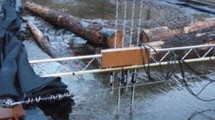Abstract
Porewater flowlines in the bed of a small Michigan USA river were shown to be altered by Chara hummocks, sea lamprey nests, and beaver dams. Altered flow lines followed expected in-bed convective and underflow patterns predicted from published models. The greater density and shape of Chara hummocks caused upwellings into the hummocks, possibly being of benefit to the plants through contact with higher levels of dissolved substances contained in the cooler, deeper porewater. Streamwater downwelling into the more permeable sea lamprey nests may provide a continuous supply of well-oxygenated water, enhancing egg survival. Convective flow patterns beneath beaver dams, as well as beneath other bed surface features, may function to temporarily store dissolved streamwater substances, altering downstream transport rates, and may function to bring porewater/streamwater to the surface, affecting distributions of surface dwelling organisms.
Similar content being viewed by others
References
Applegate, V. C., 1950. Natural history of the sea lamprey, Petromyzon marinus, in Michigan. U.S. Fish Wildlife Serv. Spec. Sci. Rep. Fish 55: 1–237.
Bencala, K. E., 1984. Interactions of solutes and streambed sediment 2. A dynamic analysis of coupled hydrologic and chemical processes that determine solute transport. Wat. Res. 20: 1804–1814.
Cooper, A. C., 1965. The effect of transported stream sediments on the survival of sockeye and pink salmon eggs and alevins. Int. Pacific Salmon Fish. Comm. Bull. 18, 71 pp.
Danielopol, D. L., 1980. The role of the limnologist in groundwater studies. Int. Revue ges. Hydrobiol. 65: 777–791.
Davis, S. N., 1969. Porosity and permeability of natural materials. In R. J. M. De Wiest (ed.), Flow through porous media. Academic Press, New York, New York: 54–89.
Fortner, S. L. & D. S. White, 1988. Groundwater seepage: a factor influencing the distributions of lotic aquatic vascular plants. Aquat. Bot. 31: 1–12.
Freeze, R. A. & J. A. Cherry, 1979. Groundwater. Prentice-Hall Inc., Englewood Cliffs, New Jersey, 604 pp.
Godbout, L. & H. B. N. Hynes, 1982. The three-dimensional distribution of the fauna in a single riffle in a stream in Ontario. Hydrobiologia 97: 87–96.
Grimm, N. B. & S. G. Fisher, 1984. Exchange between interstitial and surface water: implications for stream metabolism and nutrient cycling. Hydrobiologia 111: 219–228.
Hendricks, S. P. & D. S. White, 1988. Hummocking by lotic Chara: observations on alterations of hyporheic temperature patterns. Aquat. Bot. 31: 13–22.
Hynes, H. B. N., 1983. Groundwater and stream ecology. Hydrobiologia 100: 93–99.
Jaag, O. & H. Ambuhl, 1964. The effect of current on the composition of biocenoses in flowing water streams. In Int. Conf. Wat. Pollut. Res. Lond., Pergammon Press, Oxford, Endland, 31–49.
Jackman, A. P., R. A. Walters & V. C. Kennedy, 1984. Transport and concentration controls for chloride, strontium, potassium and lead in Uvas Creek, a small cobble-bed stream in Santa Clara County, California, U.S.A. 2. Mathematical modeling. J. Hydrol. 75: 111–141.
Kennedy, V. C., A. P. Jackman, S. M. Zand, G. W. Zellweger, & R. J. Avanzino, 1984. Transport and concentration controls for chloride, strontium, potassium and lead in Uvas Creek, a small cobble-bed stream in Santa Clara County, California, USA. 1. Conceptual model. J. Hydrol. 75: 67–110.
Lee, D. R. & J. A. Cherry, 1978. A field exercise on groundwater seepage meters and mini-piezometers. J. Geol. Ed. 27: 6–10.
Littlefield, L. & C. Forsberg, 1965. Absorption and translocation of phosphorus-32 by Chara globularis Thuill. Physiol. Plant. 18: 219–296.
Naiman, R. J., J. M. Melillo & J. E. Hobbie, 1986. Ecosystem alterations of boreal forest streams by beaver. Ecology 67: 1254–1269.
Prescott, G. W., 1982. Algae of the western Great Lakes area. Otto Koeltz Sci. Publ., Koenigstein, W. Germany, 977 pp.
Scott, W. B. & E. J. Crossman, 1973. Freshwater fishes of Canada. Fish. Res. Bd Can. Bull. 184, 966 pp.
Shepherd, B. G., G. F. Hartman & W. J. Wilson, 1986. Relationships between stream and intragravel temperatures in coastal drainages, and some implications for fisheries workers. Can. J. Fish. aquat. Sci. 43: 1818–1822.
Thackson, E. L. & K. B. Schnell, 1970. Predicting effects of dead zones on stream mixing. Proc. Am. soc. Chem. Eng. 96(SA2): 319–331.
Thibodeaux, L. J. & J. D. Boyle, 1987. Bedform-generated convective transport in bottom sediment. Nature 325: 341–343.
Tindall, D. R., 1962. Life history and ecology of Nitella flexilis (Characeae). Master's Thesis, Univ. Louisville, Louisville, Kentucky, 77 pp.
Vaux, W. G., 1962. Interchange of stream and intergravel water in a salmon spawning riffle. U.S. Fish Wildl. Serv. Spec. Sci. Rept.-Fish. No. 405, 42 pp.
Vaux, W. G., 1968. Intergravel flow and interchange of water in a streambed. Fish. Bull. 66: 479–489.
Vannote, R. L., G. W. Minshall, K. W. Cummins, J. R. Sedell & C. E. Cushing, 1980. The river continuum concept. Can. J. Fish. aquat. Sci. 37: 130–137.
Wallis, P. M., H. B. N. Hynes & S. A. Telang, 1981. The importance of groundwater in the transportation of allochthonous dissolved organic matter to the streams draining a small mountain stream. Hydrobiologia 79: 77–90.
White, D. S, C. H. Elzinga & S. P. Hendricks, 1987. Temperature patterns within the hyporheic zone of a northern Michigan river. J. N. Am. Benthol. Soc. 6: 85–91.
Wigley, R. L., 1959. Life history of the sea lamprey of Cayuga Lake, New York. U.S. Fish Wildlife Serv. Fish. Bull. 154: 561–617.
Williams, D. D., 1984. The hyporheic zone as a habitat for aquatic insects and associated arthropods. In V. H. Resh & D. M. Rosenberg (ed.), The ecology of aquatic insects. Preager Publ., New York, New York: 430–455.
Author information
Authors and Affiliations
Rights and permissions
About this article
Cite this article
White, D.S. Biological relationships to convective flow patterns within stream beds. Hydrobiologia 196, 149–158 (1990). https://doi.org/10.1007/BF00006106
Received:
Accepted:
Issue Date:
DOI: https://doi.org/10.1007/BF00006106




